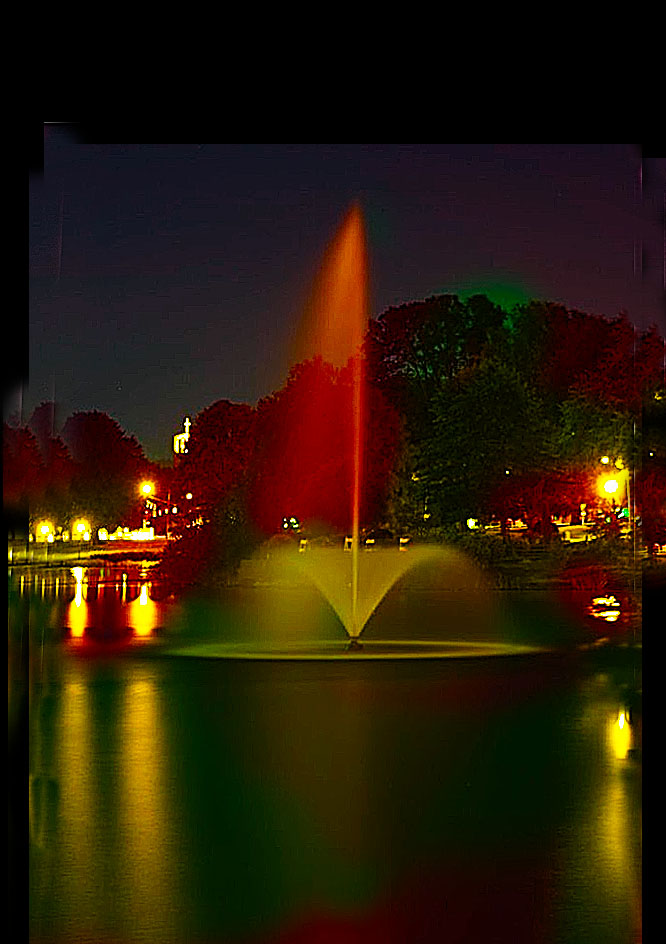Cody White
Member

Lake Sacajawea Fountain, Longview, WA
how does it work?


Lake Sacajawea Fountain, Longview, WA
how does it work?
Looking at the way the sun is shining I would try to use a polariser to darken the sky and, possibly, at the same time the fountain might look stronger,
Jeremy
Alain,Second, and more importantly, an important step in improving digital photograph is to stop thinking of how to alter the photo during shooting and start thinking of altering the photo in post processing. The sky color, as well as any other color, can be easily altered during raw convertion or, if you use it, in Photoshop.
In this case, what would you do about the color of the water and still have a feeling of night?
See above.
Alain,
Not what can Cody do but what would you do, in this case to the water?
Asher
But, Cody, even if you adopted a more moderate, sensitive eye for tonality and applied it to this image what would you really have? A picture of a fountain, and not a very interesting fountain at that. You've given viewers nothing of value.
May I make a suggestion? Instead of devoting much time behind a keyboard allocate more time to building your frames. By that I mean spend much more time learning to see. Don't just point your lens at something and click. You're not hunting. Compose your frames with context, with other elements that support the image you're trying to capture. Forget the computer crappola for a few months; just do what you must to get the images to the computer so that you can study them. STUDY the work of photographers whose work you admire. Don't just look at their work, but STUDY how they've built each frame. It's not accidental.
Devoting more time to studying / practicing how to craft interesting frames will pay dividends for the reast of your photo life.


to Alain,
... what would you do about the color of the water and still have a feeling of night? I'd be tempted to add reflections from neon signs or city lights. but that's me, I have no conscience for the truth here.
First, the title of this thread "Fountain at night" clearly indicates that there is no direct sunlight (unless the sun started shining at night)!
Second, and more importantly, an important step in improving digital photograph is to stop thinking of how to alter the photo during shooting and start thinking of altering the photo in post processing. The sky color, as well as any other color, can be easily altered during raw convertion or, if you use it, in Photoshop.
Thanks you all for taking the time to help me out.
Now here is a resized original copy with no corrections, Straight out of camera.

Cody White: Fountain at Night
Original
I'm not very good with all the masking most all of you do so I went the faster way of just cloning out all the over exposed lights and other distractions on the edited copy.


Thanks you all for taking the time to help me out.
Now here is a resized original copy with no corrections, Straight out of camera.

I'm not very good with all the masking most all of you do so I went the faster way of just cloning out all the over exposed lights and other distractions on the edited copy.
Hello Alain,

Jeremy.

Nice photo, Jeremy. But you need to "clone-out" all those little white spots in your sky. (And clean your sensor.) It doesn't look like the real night sky I see in downtown Chicago.

Lake Sacajawea Fountain, Longview, WA
how does it work?
Ken,Can you recognize that even this ugly straight-out-of-camera version is more interesting than the version you posted?
Oh my. I'm afraid we're not getting through. Oh well....
Cody,
It works for me on a number of levels for me ....
it’s a monument wasting energy that could be better used.. and although they are common I feel they should be represented...
like the court house image ... its edges don’t matter because of your direct approach... i think the colours (sat and con) burst this image... and I like it for that... it not an anal image... with perfect balance.. but its not about that.... tones sometimes shout – sometimes scream – and sometimes whisper
could you make it better... well no...
it’s made ... it would only be different ...
the real question I have to ask is... why ask how it works.. Because that implies you understand it works (which I believe you do)...
the funny thing about beauty is its in the eye...
thanks for sharing this.
Ken,
I'm trying to learn.
And no I have never hear any of those names untill now.
we have so called art galleries up here and one of them have photo's in it.
I looked at them and they seem just plain boring, and I do see some of them as something a little kid would of took.
Cody
A 1Ds3 and L lenses would not help you progress - it might even hinder you.
Hello Alain,
I guess my experience is quite different from yours. To me blue implies natural sunlight (no matter how dim). Here is a picture taken on one of my trips to investigate a location for night photography in natural light.
For intents and purposes the area looked "pitch black" notice that the sky is blue and there is some illumination of the hill side from street lights. Notice most of the stars are white. This is what one sees in very lightly polluted areas.
Regards,
Jeremy.
